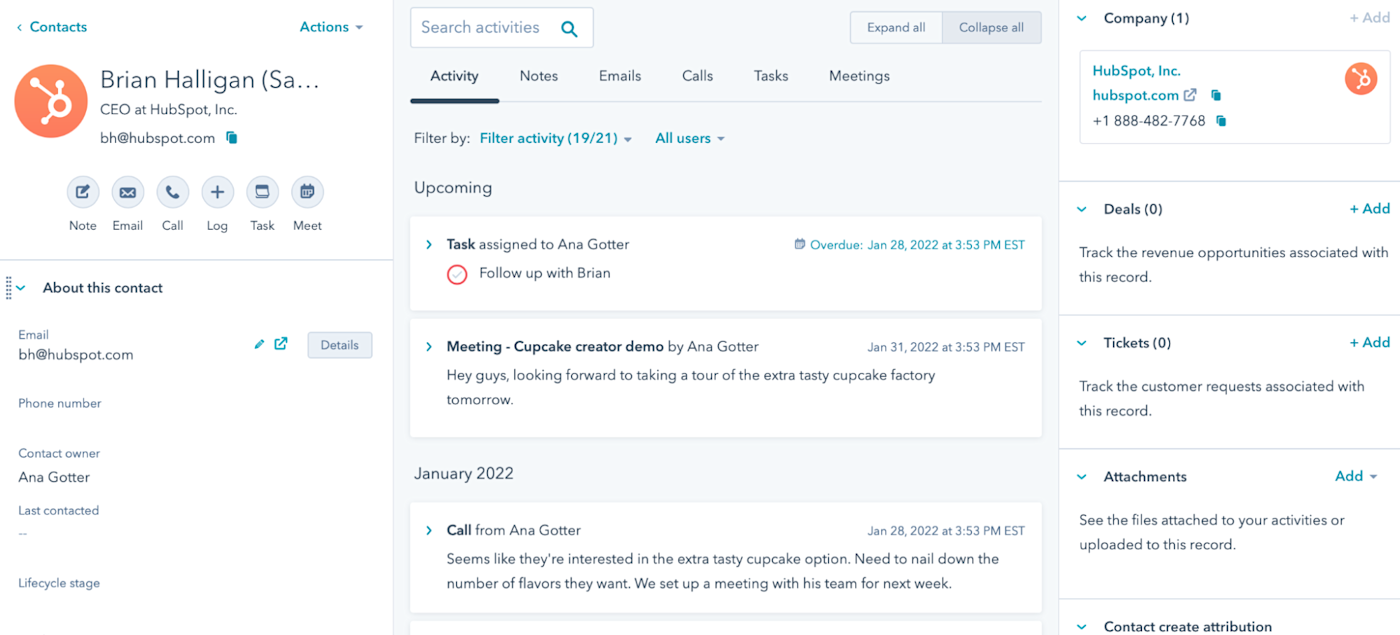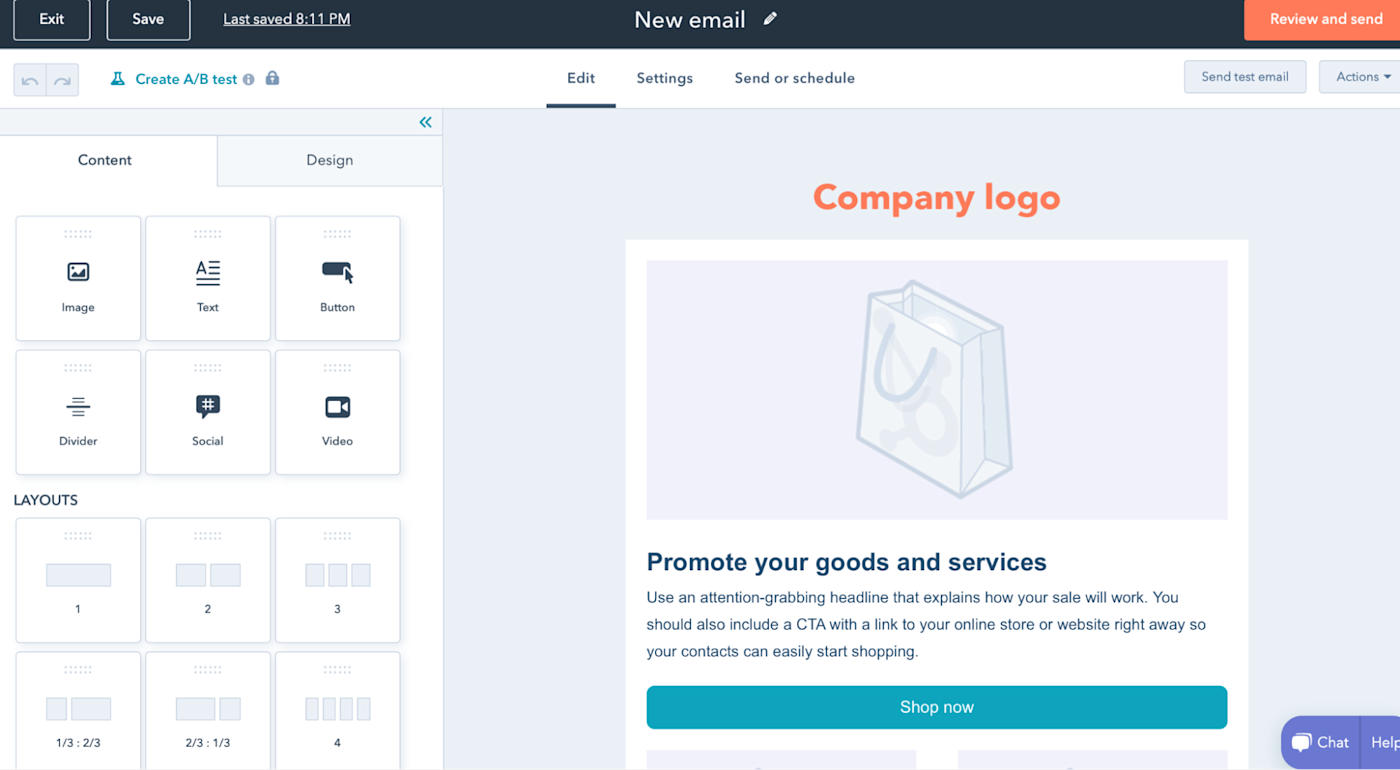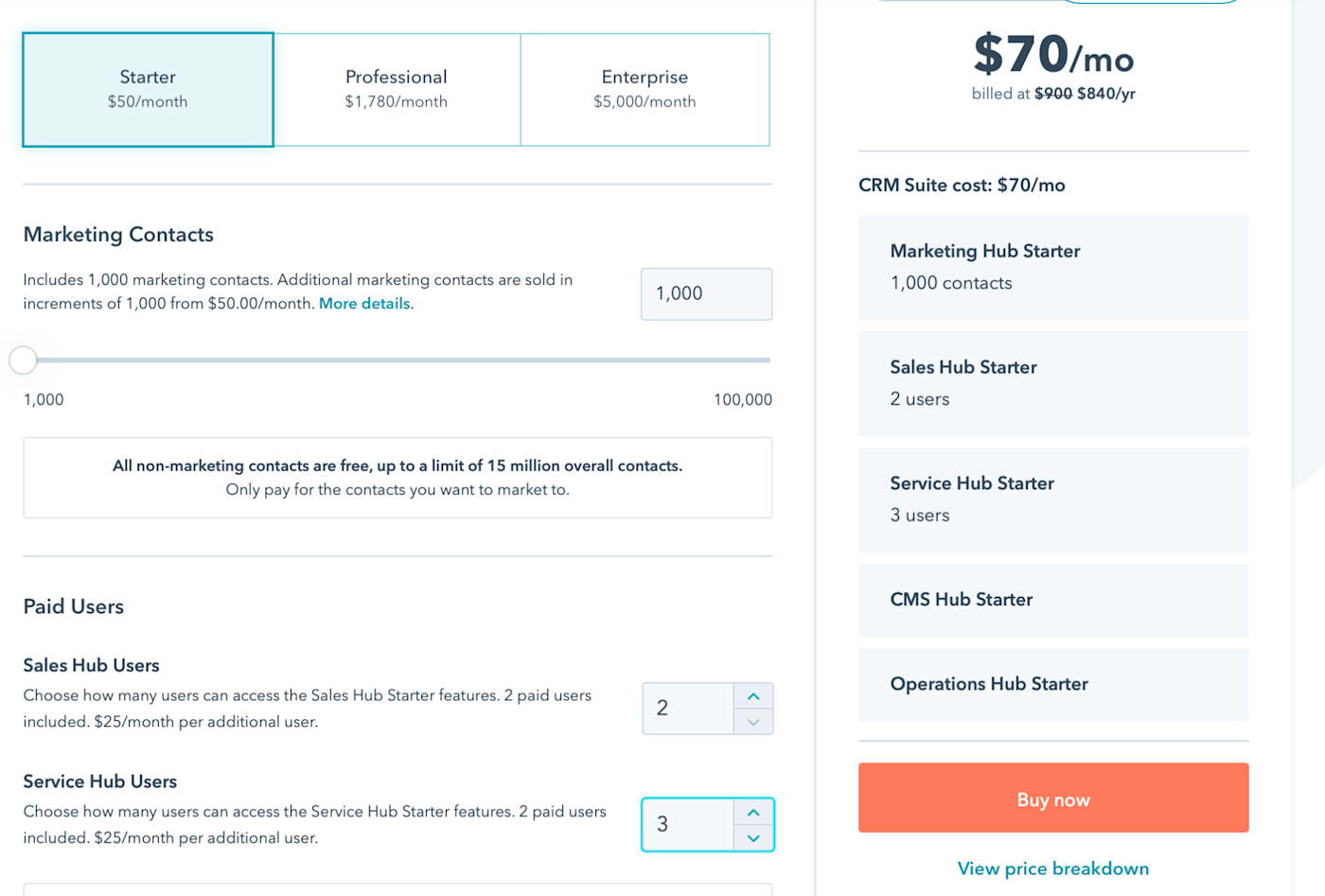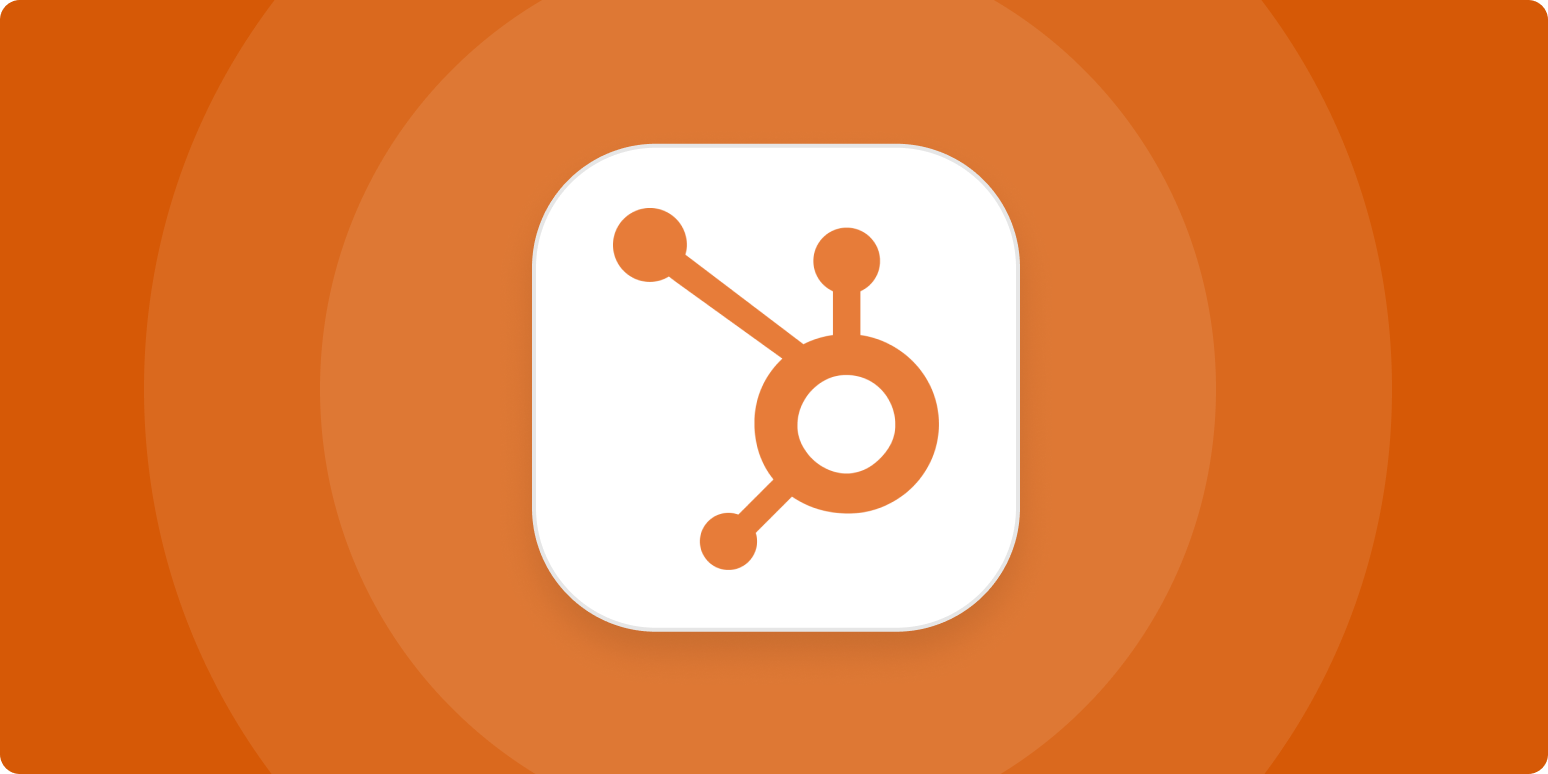HubSpot coined the term inbound marketing, but saying something is an inbound marketing tool doesn’t mean much when you don’t know what inbound marketing actually means.
So let’s start there: inbound marketing is when you don’t chase after clients or customers—they come to you. And HubSpot’s software serves this idea with all of its diverse features. Here’s a quick list of what HubSpot offers, just to give you an idea of how bananas wide-ranging they are:
-
Content management
-
Lead generation forms
-
Lead management tools (CRM, lead scoring, automated workflows)
-
Search engine optimization (via targeted content production)
-
Live chat
-
Website analytics
-
Customer support ticketing
It really is an all-in-one tool for marketing and sales. And while it’s a lot to learn, it’s worth understanding everything it can do. I’ve used HubSpot’s CRM for myself and its marketing tools on behalf of my clients, so I can tell you from experience that HubSpot is more than a nod-and-smile-and-pretend-you-know-what-it-does kind of tool. It can streamline your marketing and up your sales, even if you’re not in the marketing industry or familiar with any of the jargon.
Here, I’ll go over everything you can do with HubSpot without inundating you with marketing words that make no sense.
What is HubSpot?
HubSpot is most well-known for its powerful CRM and inbound marketing tools, but it comes with other specialized tools for each of the following:
More on each of those below.
Who uses HubSpot?

Because of its varied tools, HubSpot serves pretty much anyone running a business or working on a marketing or sales team. That’s part of why it’s hard to grok: it’s everything to everyone.
Examples include:
-
Blog editors who want to add pop-up subscribe modals to their blog
-
Sales managers who want to identify warm and hot leads to increase sales
-
Customer service managers who want to follow up on customer complaints quickly
-
Marketing specialists who want to assess the performance of their campaigns
And that’s just the tip of the iceberg.
The 6 core HubSpot Hubs
The six core functions of HubSpot are called “Hubs,” and each Hub comes with its own suite of tools. Click on a Hub name to learn more below, or take a look at the table below to help you wrap your head around the setup.
-
Service
-
CRM
-
CMS
-
Marketing
-
Sales
-
Operations
| Service | CRM | CMS | Marketing | Sales | Operations | |
|---|---|---|---|---|---|---|
| Core focus | Tracking and facilitating customer service | Managing customer relationships | Building and managing your website | Creating marketing campaigns to attract leads | Leveraging customer data to drive sales | Streamlining processes for your team |
| Key features | Customer help desk and support library features; Direct customer messaging through multiple platforms; Detailed analytics and forecasting | Database containing all customer data; Meeting scheduling; Live chat and support | SEO recommendations and split testing; Pre-built themes; Allows for custom code; Contact attribution | Blog publishing; Manage SEO; Ad tracking; Email marketing; Landing page and form builder; Detailed analytics | Conversation tracking; Email templates; Meeting scheduling; Custom quotes and deals; Pipeline management and tracking; Sales reporting | Marketing automation; Data syncing; Workflow extensions; Data curation; Custom report builder |
HubSpot Service Hub
HubSpot’s Service Hub, aptly named, is centered around customer service. Anything you need to do to support your customers and create a frictionless experience, HubSpot Service has you covered.
The suite, as a whole, includes all of the following features (but the extent of the features available to you differ from plan to plan):
-
Streamlined help desk and ticketing, which includes routing tickets to prioritize critical issues
-
Knowledge base support to set up searchable resource libraries
-
Live chat support for customers on your website, with smart routing
-
Customer portals to keep ticket conversations going between your team and your customers
-
VoIP calling (for select plans), which includes call analytics
-
1:1 video messaging
-
A dashboard combining messages from the team’s email, live chat, and messenger
-
Customer feedback surveys to get insight into their experience
-
Conversational intelligence features to capture details from every call and interpret it with AI-powered insights
-
Forecasting for future sales and customer experiences
-
Contact scoring to help your team assess customer happiness and determine if any relationships need a little extra care
-
Reporting and analytics to assess customer satisfaction and team performance
HubSpot CRM Suite
HubSpot’s free CRM takes all of the data you gleaned from your Service tool (if you use it), assigns it to specific customers, and helps you provide tailored support to your customers going forward. Even if you aren’t using the Service tool, the HubSpot CRM tracks all of your leads and customers to facilitate an optimal user experience.
Included in the free CRM tool are:
-
A database of your leads and customers, with detailed information like engagement, recent purchases, and a detailed sales and customer support history
-
Email tracking and notifications
-
Prospect tracking as they move through the funnel
-
Meeting scheduling features
-
Live chat support

The CRM lets your marketing team learn more about the leads they’re attracting, while sales and customer service can easily pull up a customer’s full history for tailored support. Everyone’s on the same page, working toward the same goal.
HubSpot CMS Hub
HubSpot’s Content Management System (CMS) can actually build your entire site without working extensively with developers (though you can, if you’d like).
Personally, I’ve used HubSpot’s CMS with a few clients and have always found the system easy to learn and use. One client—who migrated from WordPress—said the site migration process was pretty straightforward.
Features include:
-
Pre-built website themes that can be customized by developers
-
SEO recommendations for each page
-
The ability to fully and easily integrate your site data with your CRM
-
A drag-and-drop design editor
-
Split testing with up to five different versions of a single page
-
Analytics based on which campaigns and sources drive the most sales
HubSpot Marketing Hub
As someone who works extensively in marketing, I’ve found HubSpot to be a pretty phenomenal all-in-one marketing tool that keeps all of your data under one convenient roof. Having all of your marketing campaigns and data in one space helps you avoid silos and creates transparency for your team—and gives you a comprehensive overview all in one spot.

Their marketing suite of features includes:
HubSpot Sales Hub
HubSpot’s sales software tracks your data and leads to help you close deals.

All of that data from your CRM comes into play here, with features designed to help you identify all relevant leads and drive sales fast. The HubSpot sales tool includes the following features:
-
Conversation tracking, including calls and emails
-
Email templates
-
Document tracking
-
Conversation intelligence (AI that spots opportunities for improvement)
-
Payment acceptance
-
Meeting scheduling
-
Sales funnel tracking
-
Custom quote generation
-
Sales analytics
HubSpot Operations Hub
If your business is trying to scale, you should consider taking a look at HubSpot’s operations software. It’s automation-heavy, freeing you and your team up to complete other tasks that can’t be automated, and it’s designed to increase data accuracy while compiling information for your brand. No more missed orders or order shipments because your data is clogged.
Features include:
HubSpot pricing
With a lot of features comes some relatively complex pricing. But once you understand the structure, it’s pretty easy to figure out what you’ll need.
HubSpot’s all-inclusive free plan
There’s something to be said about having all of your data from sales, marketing, operations, and more all in one place—a business bible, if you will. It increases transparency and communication without letting any leads or unresolved issues slip through the cracks.
HubSpot’s free overarching plan includes some features from each of the different, individual Hubs (payment unlocks more functionality, of course). Free features include:
-
Contact management, including website activity, companies they’re from, and deals
-
Task and activity assignment
-
Form and landing page builders
-
Email marketing and email scheduling
-
Ad management
-
Live chat with basics bots
-
Team email and shared inbox
-
Ticketing
-
Data sync
-
Historical sync
-
Default field mappings
-
App marketplace integrations
Completely free standalone features include (but are not limited to):
HubSpot’s paid plans
Outside of the free software, HubSpot’s pricing works based on the Hub or suite you choose (Marketing, Sales, etc.), the level you’d like based on your business’s scale (Starter, Professional, or Enterprise), and whether you’d like to pay monthly or all upfront.
Each plan upgrade comes with additional features, but you’re also getting the following:
-
An increase in users (2 with Starter, 5 with Professional, and 10 for Enterprise for each individual hub of tools)
-
A boost in marketing contacts (1,000 for Starter, 2,000 for Professional, and starting at 10,000 for Enterprise)
Add on more paid users and/or contacts to any plan for an additional cost when you start scaling. Or never add more users because you’re a solopreneur—HubSpot’s flexibility is its key selling point.

Automate HubSpot
HubSpot natively integrates with more than 1,000 other apps, so it can talk to whatever other software you use every day. Your data will flow, and no silos will be had. If you can’t find the integration you need, you can use Zapier to connect HubSpot to thousands of other apps. Learn more about how to automate HubSpot.
[adsanity_group align=’alignnone’ num_ads=1 num_columns=1 group_ids=’15192′]
Need Any Technology Assistance? Call Pursho @ 0731-6725516







